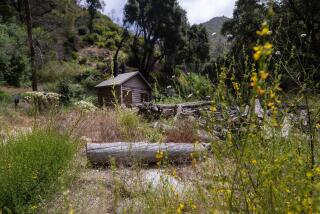Spring cleaning
- Share via
The season of conflicting scents and instincts is upon us. Down from the hills waft traces of sage and woolly blue curl. Out of the attic and garage drift the aromas of leaking Deet and mildewed Gore-Tex.
Over the next several weekends, these smells will simultaneously undermine motivation to work while inflaming enterprise in service of play. This is perfectly natural. Remember to smile as you sneak out of the office early to hose down a tent or patch a sleeping bag.
It goes without saying that you celebrated the end of last backpacking season by scrubbing each tent stake and making a detailed list of what needs to be fixed or replaced. Right?
If not, now’s the time.
This task will be easier if you organize everything in one or two places, says Dana Nelson, who hikes with her 3-year-old daughter and is camping manager at REI in Arcadia. She keeps one backpack stuffed with gear for weeklong backpacking trips, and another filled with camping essentials from olive oil to marshmallow toasting sticks and towels.
The first camping items Nelson recommends checking on are “anything fire-related.” Having Domino’s deliver to your campsite would be quicker than using pooped-out matches or a depleted Bic to light a stove whose fuel has evaporated or leaked away.
So replace those matches or other igniters and refill or refuel. Then clean the stove and unclog the burners.
Next, make sure you’ll be able to see. Replace lantern mantels and batteries for flashlights and headlamps.
*
A fresh start
Dehydrated meals have a long shelf life -- and some taste like it -- but if you have any left over from the first Bush administration, it’s best to toss them and start fresh. Check mess kits for missing utensils and take another run at that macaroni that wouldn’t come off if need be. Then restock spices and condiments.
A contaminated water filter can lead to gastric illness quicker than you can say “Kaopectate.” Start the season by cleaning your water purifier.
For ceramic models, filter manufacturer Katadyn recommends scrubbing the unit with the cleaning pad that came with it.
For glass-fiber, pleated-filter models, the company advises running a solution of two teaspoons of bleach in a liter of water through the filter, then removing the cartridge and allowing it to dry.
Check for clogs in pump filters and replace filter elements if they’re contaminated.
Forgot to store your hydration pack’s water bladder without leaving it open? Moldy bladders stink, but luckily they’re cheap to replace.
Always toss items that have passed their expiration dates, such as those in first-aid kits, along with bug spray and sunscreen.
Now, too, is the time to yank sleeping bags off the hangers on which they’ve been airing or out of the big, loose sack in which you stored them -- please tell me you didn’t put them away in loft-crushing little stuff sacks.
Check for tears and make sure zippers work while there’s time to send them back to their manufacturers for repairs. And don’t forget to check for leaks in inflatable sleeping pads.
*
Summer prep
Next set up your tent, sweep it out, spray it with a hose and let it air dry, says Nelson. If water is seeping through the seams, apply seam sealer, using several thin coats of the goo.
If the tent got mildewy since its last use, you can stop further damage, but removing the stain is impossible, according to the North Face.
To stop mildew from spreading, the company recommends sponge-wiping the tent with a solution of one-half cup Lysol to one gallon of hot water, leaving the solution on and allowing it to dry. Then, mix a cup of salt and a cup of concentrated lemon juice with one gallon of hot water. Rub the solution into the visible mildew and once again allow it to dry.
Nelson also recommends checking the tent’s ground sheet and patching any rips or punctures. And it’s best not to wait until dark at 12,000 feet to discover missing stakes or broken poles.
Nelson suggests giving hiking boots a fresh start with a new pair of footbed inserts such as Superfeet. These add support and life to boots and human soles, she says.
Other summer prep work includes sharpening knives and axes, replenishing tent and fabric repair kits and replacing worn components on backpacks and buying extra straps.
Finally, dust off the maps, get out a calendar and make a long, long list of the dates to tell your boss you’re taking off.
*
To e-mail Julie Sheer or read her previous Outdoors Institute columns, go to latimes.com/ juliesheer.


